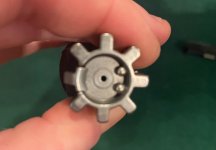Attached is a photo of my bolt head (semi-auto). The weird thing is that I've only shot handloads with a minimum charge and have not worked a load up just yet. Is this normal for AR10 type platforms? The rifle has plenty of rounds through it and only a few rounds were handloaded for testing? Also, I did not see any pressure signs on the brass when using the few handloaded rounds.
- Thread starter thepatchcable
- Start date
You are using an out of date browser. It may not display this or other websites correctly.
You should upgrade or use an alternative browser.
You should upgrade or use an alternative browser.
It looks fine in that blurry ass photo. What are you seeing?
The full moon on the head?It looks fine in that blurry ass photo. What are you seeing?
Picture it too blurry to interpret, but if there's any etching going on in that ring, you've got a problem.The full moon on the head?
Run your finger nail across that ring to see if it cut into the metal.
That is literally nothing.
Every single bolt on every rifle that’s ever been shot either currently has, or has had in the past, that ring around the firing pin hole.
In all but a few cases (hahaha, see what I did there) it’s debris that collects on the bolt face in the space left as the primer curves down into the pocket…carbon, shards of brass, dirt, etc.
In very few cases (again, I crack myself up) it’s bolt face damage from WAY OVER pressure causing extremely hot gas to escape around or through the primer and literally “cutting torch”the bolt face.
It’s up to you to decide which case applies to you.
Every single bolt on every rifle that’s ever been shot either currently has, or has had in the past, that ring around the firing pin hole.
In all but a few cases (hahaha, see what I did there) it’s debris that collects on the bolt face in the space left as the primer curves down into the pocket…carbon, shards of brass, dirt, etc.
In very few cases (again, I crack myself up) it’s bolt face damage from WAY OVER pressure causing extremely hot gas to escape around or through the primer and literally “cutting torch”the bolt face.
It’s up to you to decide which case applies to you.
As a new guy, I expect you to ask this, and there's nothing wrong with the question. It tells me that you're seeing evidence of some of the mayhem that occurs as powder combusts/deflagrates under pressures, and you'd like to know whether it's reasonable mayhem, or "Whoa, Nelly" mayhem; what I call an intelligent question.
If you have a question; ask it. If you don't you are at least as likely to come way with the wrong impression. The ways we work with cartridges and firearms can have serious consequences; so ask.
OREGUN has what would have been my answer. I've had both sorts of that mayhem. Scratch a paperclip end over the mark.
If it's a groove, it's gas cutting, at least in part. This is a very likely indicator of moderately to very serious excess pressure. If it's coming from handloads, they're at least borderline too hot. Redevelop your loads cooler, and don't be disappointed; all that hotloading really achieves is premature barrel demise..., or worse. If your chambering doesn't deliver enough energy, you need a larger chambering, not a hotter load.
If it's factory ammo, see if you can send it back with some (clearer) pictures of the consequent mayhem being inflicted on your firearm. You may get some recompense.
If it's a shallow ridge, its crud. You could clean it off, but really, it's just gonna come back again anyway; a fact of the shooting life.
Greg
PS I bought a nice (cheap) set of dental explorer tools some years back, intending to pack then in my range bag(s). Sure enough, they're still sitting on the vanity counter.
I am getting Elder, so I am in what will be a lifelong search for simplicity in my rifle sports. One of my sub-goals is to reduce my number of propellants. While I'm at it, I'm looking for ones that work in a broader array of applications, and which may have some benefits for the rifles themselves. Right now I'm down to H-110 (.44Mag), W748 and W760, and I'm also looking carefully into Ramshot LRT.
H-110 is a good propellant for the 44Mag, affordable, and perhaps more often available.
W748 and W760 are spherical powder, which meter very well. They are attributed to have a lower combustion temp for a given velocity, and they are somewhat dirty according to some. IMHO, that dirt is graphite, unburnt kernel coating. I see it as a dry bore lubricant, much as Moly has (had?) been of late. I leave it in the bore until I get that itchy/gitchy feeling between the shoulder blades and can no longer, in good conscience, put the gun away without a good cleaning. This is not a definable term. But we all know how it feels. Never hurts to listen more closely to such undefinables.
R/S LRT is a reeeally slow spherical powder. I think I may like it for my 260, because the 28" bore is very long and the chamber is somewhat overbore. In a 24" barrel the powder tended to be very accurate, but loads were a seriously slower in my 24" barrel of some decades back. I found that I could fill the case with another slow powder, add a 140gr bullet, and try as I might, it never developed pressure signs. I figure with the longer barrel, higher load density might bring the velocity back into a more favorable zone, without the more usual pressure risk of such higher load densities. Still early in this game; so don't get wrapped around this axle just yet.
If you have a question; ask it. If you don't you are at least as likely to come way with the wrong impression. The ways we work with cartridges and firearms can have serious consequences; so ask.
OREGUN has what would have been my answer. I've had both sorts of that mayhem. Scratch a paperclip end over the mark.
If it's a groove, it's gas cutting, at least in part. This is a very likely indicator of moderately to very serious excess pressure. If it's coming from handloads, they're at least borderline too hot. Redevelop your loads cooler, and don't be disappointed; all that hotloading really achieves is premature barrel demise..., or worse. If your chambering doesn't deliver enough energy, you need a larger chambering, not a hotter load.
If it's factory ammo, see if you can send it back with some (clearer) pictures of the consequent mayhem being inflicted on your firearm. You may get some recompense.
If it's a shallow ridge, its crud. You could clean it off, but really, it's just gonna come back again anyway; a fact of the shooting life.
Greg
PS I bought a nice (cheap) set of dental explorer tools some years back, intending to pack then in my range bag(s). Sure enough, they're still sitting on the vanity counter.
I am getting Elder, so I am in what will be a lifelong search for simplicity in my rifle sports. One of my sub-goals is to reduce my number of propellants. While I'm at it, I'm looking for ones that work in a broader array of applications, and which may have some benefits for the rifles themselves. Right now I'm down to H-110 (.44Mag), W748 and W760, and I'm also looking carefully into Ramshot LRT.
H-110 is a good propellant for the 44Mag, affordable, and perhaps more often available.
W748 and W760 are spherical powder, which meter very well. They are attributed to have a lower combustion temp for a given velocity, and they are somewhat dirty according to some. IMHO, that dirt is graphite, unburnt kernel coating. I see it as a dry bore lubricant, much as Moly has (had?) been of late. I leave it in the bore until I get that itchy/gitchy feeling between the shoulder blades and can no longer, in good conscience, put the gun away without a good cleaning. This is not a definable term. But we all know how it feels. Never hurts to listen more closely to such undefinables.
R/S LRT is a reeeally slow spherical powder. I think I may like it for my 260, because the 28" bore is very long and the chamber is somewhat overbore. In a 24" barrel the powder tended to be very accurate, but loads were a seriously slower in my 24" barrel of some decades back. I found that I could fill the case with another slow powder, add a 140gr bullet, and try as I might, it never developed pressure signs. I figure with the longer barrel, higher load density might bring the velocity back into a more favorable zone, without the more usual pressure risk of such higher load densities. Still early in this game; so don't get wrapped around this axle just yet.
Last edited:
The is a cold hammer forged bolt head in a .308 MR762A1. There is no scratch/etch/cut into the head itself. The load I shot recently was 39.5g of N550 in PPU .308 brass with a 168g SMK. The COAL was a little under 2.85~ with a CBTO measure of 2.2395. The OAL with my chamber with the 168SMK is long, around 2.9. The brass shows NO signs over pressure but wanted to double check, as yes, I'm newer to reloading.As a new guy, I expect you to ask this, and there's nothing wrong with the question. It tells me that you're seeing evidence of some of the mayhem that occurs as powder combusts/deflagrates under pressures, and you'd like to know whether it's reasonable mayhem, or "Whoa, Nelly" mayhem; what I call an intelligent question.
If you have a question; ask it. If you don't you are at least as likely to come way with the wrong impression. The ways we work with cartridges and firearms can have serious consequences; so ask.
OREGUN has what would have been my answer. I've had both sorts of that mayhem. Scratch a paperclip end over the mark.
If it's a groove, it's gas cutting, at least in part. This is a very likely indicator of moderately to very serious excess pressure. If it's coming from handloads, they're at least borderline too hot. Redevelop your loads cooler, and don't be disappointed; all that hotloading really achieves is premature barrel demise..., or worse. If your chambering doesn't deliver enough energy, you need a larger chambering, not a hotter load.
If it's factory ammo, see if you can send it back with some (clearer) pictures of the consequent mayhem being inflicted on your firearm. You may get some recompense.
If it's a shallow ridge, its crud. You could clean it off, but really, it's just gonna come back again anyway; a fact of the shooting life.
Greg
PS I bought a nice (cheap) set of dental explorer tools some years back, intending to pack then in my range bag(s). Sure enough, they're still sitting on the vanity counter.
I am getting Elder, so I am in what will be a lifelong search for simplicity in my rifle sports. One of my sub-goals is to reduce my number of propellants. While I'm at it, I'm looking for ones that work in a broader array of applications, and which may have some benefits for the rifles themselves. Right now I'm down to H-110 (.44Mag), W748 and W760, and I'm also looking carefully into Ramshot LRT.
H-110 is a good propellant for the 44Mag, affordable, and perhaps more often available.
W748 and w760 are spherical powder, which meter very well. They are attributed to have a lower combustion temp for a given velocity, and they are somewhat dirty according to some. IMHO, that dirt is graphite, unburnt kernel coating. I see it as a dry bore lubricant, much as Moly was (had?) been of late. I leave it in the bore until I get that itchy/gitchy feeling between the shoulder blades and can no longer, in good conscience, put the gun away without a good cleaning. This is not a definable term. But we all know how it feels. Never hurts to listen more closely to such undefinables.
R/S LRT is a reeeally slow spherical powder. I think I may like it for my 260, because the 28" bore is very long and the chamber is somewhat overbore. I such a barrel the powder tended to be very accurate, but loads were a seriously slower in my 24" barrel of some decades back. I found that I could fill the case with another slow powder, add a 140gr bullet, and try as I might, it never developed pressure signs. I figure with the longer barrel, higher load density might bring the velocity back into a more favorable zone, without the more usual pressure risk of such higher load densities. Still early in this game; don't get wrapped around this axle just yet.
Can someone tell me what happened hear
Attachments
-
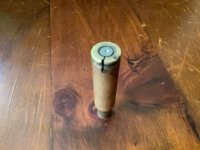 38D9E036-BFBF-4E29-BA48-DC7318AE1C13.jpeg663.8 KB · Views: 54
38D9E036-BFBF-4E29-BA48-DC7318AE1C13.jpeg663.8 KB · Views: 54 -
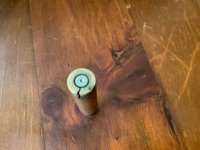 F3286B2D-0CCA-4767-A4DC-9A4B064196AF.jpeg692.8 KB · Views: 55
F3286B2D-0CCA-4767-A4DC-9A4B064196AF.jpeg692.8 KB · Views: 55 -
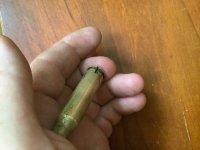 D986717D-3BFE-42EF-B20C-6318325FF3EC.jpeg565 KB · Views: 44
D986717D-3BFE-42EF-B20C-6318325FF3EC.jpeg565 KB · Views: 44 -
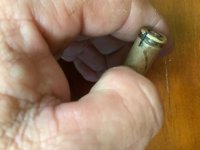 050056BD-0870-4E64-A8DC-38A93E885917.jpeg465.2 KB · Views: 39
050056BD-0870-4E64-A8DC-38A93E885917.jpeg465.2 KB · Views: 39 -
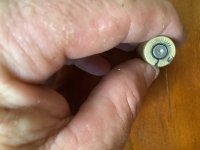 90FC0347-2526-4433-B90A-E64D5BBA7533.jpeg465 KB · Views: 54
90FC0347-2526-4433-B90A-E64D5BBA7533.jpeg465 KB · Views: 54
What happened is there was a knot in the wood where that plank was cut, that other blurry thing I dont know.Can someone tell me what happened hear
You straight up fucked that shit….Can someone tell me what happened hear
I’ve never seen that before
Wrong bolt head for the cartridge would be my first guess. Terrible over pressure if not
Can someone tell me what happenedhearhere.

Been shooting fine then this happenedYou straight up fucked that shit….
I’ve never seen that before
Wrong bolt head for the cartridge would be my first guess. Terrible over pressure if not
Looks like catering, flattened primer and an ejector mark. More details on the loads?Been shooting fine then this happened
What you should do is start a new thread of your own. Explain what weapon and give details on the ammo such whether it's a factory loading or a handload. If it's a handload, give us details like bullet, powder charge, primer, OAL.Been shooting fine then this happened
42.5 gr of benchmark 2 168 gr bulletLooks like catering, flattened primer and an ejector mark. More details on the loads?
Was reading through and thought DAMN maybe the bolt face was jacked up.What you should do is start a new thread of your own. Explain what weapon and give details on the ammo such whether it's a factory loading or a handload. If it's a handload, give us details like bullet, powder charge, primer, OAL.
Then realized it wasn’t the same topic.
Smdh.
You broke your case ... next question please ...
To the OP. The bolt has some sort of finish on it, blue, parker, teflon, etc. Upon shooting the case head and the primer eventually wear off that finish where they contact the bolt. That dark ring around the firing pin is where there is no contact, therefore the finish remains.
Now loose primer pockets or over pressure loads will allow gas to flow past causing soot/residue to form this also. In severe cases enough gas will flow past and flame etch the bolt face. As mentioned above, flame cutting can be determined with a finger nail or paper clip etc. Eventually that ring may disappear from use/cleaning.
Now loose primer pockets or over pressure loads will allow gas to flow past causing soot/residue to form this also. In severe cases enough gas will flow past and flame etch the bolt face. As mentioned above, flame cutting can be determined with a finger nail or paper clip etc. Eventually that ring may disappear from use/cleaning.
Similar threads
- Replies
- 0
- Views
- 215
- Replies
- 5
- Views
- 270
- Replies
- 53
- Views
- 1K

